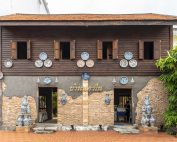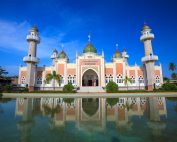Sukhothai Heritage City
Sukhothai is not only the former and first capital city of the Siamese people but also a “World Heritage Site”, as declared by UNESCO. Although 700 years have passed, the prosperity and magnificence of Sukhothai culture and art remain firmly intact. The area was once home to the royal palace and there are almost 200 temples and archeological sites scattered both inside and outside the city walls.
The 18th to 20th Buddhist centuries were the most glorious period for the Sukhothai Kingdom. Even though they may not be able to witness it first hand, walking among the ancient remains inside the Sukhothai Historical Park gives the visitor some idea of the majesty of the former capital and the people’s strong faith in Buddhist principles. Travelers should not pass by “Wat Mahathat”, the most important and largest of the royal monasteries, which enshrines a magnificent Buddha image and is surrounded by up to 200 smaller chedis. In the past, it functioned as both royal monastery and royal cemetery to the city. Wat Si Chum, on the other hand, is where Phra Achana (The Speaking Buddha Image) is enshrined although its Mondop roof has long deteriorated and only the walls remain. Even in a state of ruin it is another highlight that needs to be witnessed in person. To experience the Buddhist way of life along with the customs of Sukothai, come and join the alms-giving ceremonies in front of Wat Tra Phang Thong before continuing inside to admire the impressive architecture of the main bell-shaped chedi which is encircled by eight smaller chedis and a creates a remarkable reflection in the front pond.
As well as featuring prominently in Thailand’s history, Sukhothai is also the birthplace of Sangkhalok (Sukhothai ceramics), Sukhothai gold and silverware and mud-fermented fabrics by Baan Na Ton Chan. The production of these items has been maintained to this very day and interested visitors are able to try their hand at them.
The wide array of must-try local food includes Kuai Tiao Sukhothai (Sukhothai Noodles), Khao Poep Sukhothai (Steamed Rice Noodles Roll Soup), Mi Phan (Steamed Rice Flour Crepe-like skin with noodle filling). Travelers can sample all of these whilst leisurely biking around the city and helping to reduce pollution and environmental damage. If you are tired, you can simply take a rest under the shade of one of the large trees, although you should always remember to bring a personal water bottle to freshen up as and when needed.
Highlight Activities
- Bike around the city and bask in the grandeur of Siam’s first capital.
- Experience the romantic atmosphere with Sukhothai Light Up Night (held on special occasions).
- Observe the precision and skill used in the making of Sangkhalok ceramics and try hand-drawing Sangkhalok patterns on the fabric.
- Learn about the making of Baan Na Ton Chan’s mud-fermented fabric whose extraordinary softness derives from natural weaving techniques.
- Taste authentic local food and support community products.
Best Time to Visit
- All year round.
- Sukhothai Historical Park opens every day (Sunday-Friday 6.30 a.m.-7.30 p.m. and Saturday 6.30 a.m.-9 p.m. (except for night light shows and illuminated night sightseeing).











